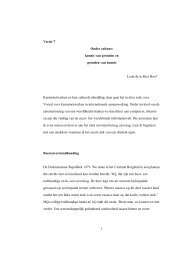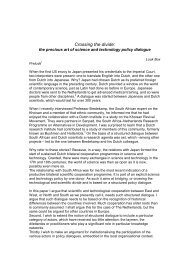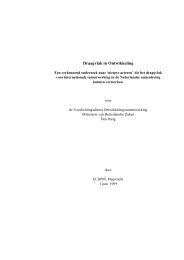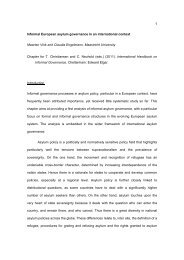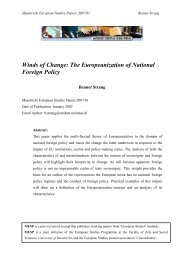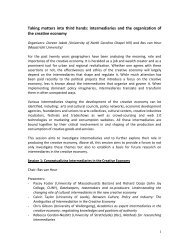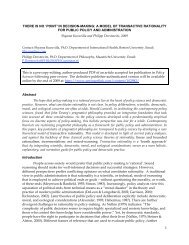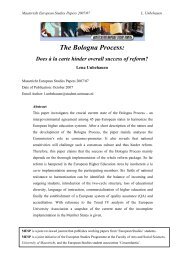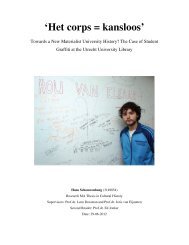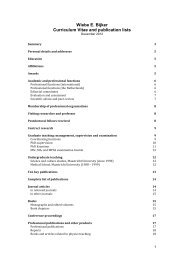the case of the synthetic dye industry, 1857–1914 - Maastricht ...
the case of the synthetic dye industry, 1857–1914 - Maastricht ...
the case of the synthetic dye industry, 1857–1914 - Maastricht ...
You also want an ePaper? Increase the reach of your titles
YUMPU automatically turns print PDFs into web optimized ePapers that Google loves.
180 J.P. Murmann and E. Homburg<br />
2 Patterns <strong>of</strong> evolution at <strong>the</strong> global level<br />
Number <strong>of</strong> producers (density)<br />
William Henry Perkin, <strong>the</strong> inventor <strong>of</strong> <strong>the</strong> first syn<strong>the</strong>tic <strong>dye</strong>, started production <strong>of</strong><br />
aniline purple near London at <strong>the</strong> end <strong>of</strong> 1857 and remained <strong>the</strong> only producer<br />
for at least a few months. To commence <strong>dye</strong> production, Perkin also had to<br />
develop processes to make crucial chemical inputs, <strong>the</strong> so-called ’intermediates’<br />
(i.e. organic chemical compounds that are made from raw materials). While some<br />
<strong>of</strong> <strong>the</strong> organic intermediates were already made for o<strong>the</strong>r industrial purposes,<br />
Perkin could not buy all necessary intermediates in <strong>the</strong> market and had to make<br />
nitro-benzene, for example, in-house.<br />
The year 1858 already saw a dramatic increase to 8 firms participating in<br />
<strong>the</strong> <strong>industry</strong>. 4 The number <strong>of</strong> firms continued to increase steeply in <strong>the</strong>se early<br />
years. By 1864 a temporary maximum <strong>of</strong> 68 firms was reached. Over <strong>the</strong> next<br />
fifty years <strong>the</strong> global population grew much more slowly, reaching a peak <strong>of</strong><br />
about 84 firms (see Fig. 1, upper graph).<br />
If we restrict our analysis to <strong>the</strong> five leading countries, Britain, France, Germany,<br />
Switzerland, and <strong>the</strong> USA, <strong>the</strong> patterns look very similar, except for <strong>the</strong><br />
period after 1900, when <strong>the</strong> number <strong>of</strong> firms drops for <strong>the</strong> 5-country aggregate<br />
but rises for <strong>the</strong> entire world. The number <strong>of</strong> firms in a given year is, <strong>of</strong> course,<br />
determined by <strong>the</strong> number <strong>of</strong> firm entries and exits since <strong>the</strong> previous year. Showing<br />
in more detail <strong>the</strong> global <strong>industry</strong> dynamics <strong>of</strong> <strong>the</strong> early years, Figure 2 plots<br />
<strong>the</strong> 3-year moving averages <strong>of</strong> <strong>the</strong> number <strong>of</strong> entries and exits in each year. The<br />
entry graph reveals that <strong>the</strong> largest amount <strong>of</strong> entry occurred very early in <strong>the</strong><br />
<strong>industry</strong> around 1863.<br />
The rapid entry <strong>of</strong> firms between 1858 and 1864 was propelled by a strong<br />
demand for aniline <strong>dye</strong>s, especially in <strong>the</strong> field <strong>of</strong> luxury textiles (silks) and<br />
highly priced fashionable designs. The number <strong>of</strong> syn<strong>the</strong>tic <strong>dye</strong> producers rose<br />
so quickly that <strong>the</strong> intensifying competition soon led to falling prices for <strong>the</strong><br />
new <strong>dye</strong>s. By 1864, <strong>the</strong> price <strong>of</strong> fuchsine (aniline red), for instance, had fallen<br />
to about ten percent <strong>of</strong> <strong>the</strong> 1860 levels (Morris and Travis, 1992, p. 65). A<br />
number <strong>of</strong> firms could not cope with <strong>the</strong> swift decline in prices that resulted<br />
from production overcapacity and were forced to exit. The number <strong>of</strong> exits at<br />
<strong>the</strong> global level peaked in 1864 with 9 exits (see <strong>the</strong> firm exit graph in Fig. 2). 5<br />
The period from 1864 to 1869 was marked by a process <strong>of</strong> consolidation.<br />
Many companies now produced more than a few <strong>dye</strong>s and <strong>of</strong>fered a full “rainbow”<br />
<strong>of</strong> <strong>dye</strong>s to customers. This proliferation <strong>of</strong> syn<strong>the</strong>tic <strong>dye</strong>s led to a decline<br />
in sales <strong>of</strong> such natural <strong>dye</strong>s as archil and cochenille-carmine. 6 But competition<br />
4 All graphs in figures report three-year moving averages.<br />
5 Meyer-Thurow studied contemporary reports <strong>of</strong> chambers <strong>of</strong> commerce in Germany and found<br />
that local <strong>of</strong>ficials became quite aware <strong>of</strong> a crisis in <strong>the</strong> <strong>dye</strong> <strong>industry</strong> in <strong>the</strong> years 1863-4. Manufacturers<br />
complained about falling prices and typically blamed overcapacities for <strong>the</strong> difficulties in<br />
selling product (personal communication to one <strong>of</strong> <strong>the</strong> authors).<br />
6 It took several decades before all natural <strong>dye</strong>s were replaced by syn<strong>the</strong>tic equivalents. Natural<br />
<strong>dye</strong>s such as <strong>dye</strong>woods were produced on a large scale until <strong>the</strong> 1880s and to a lesser extent well



